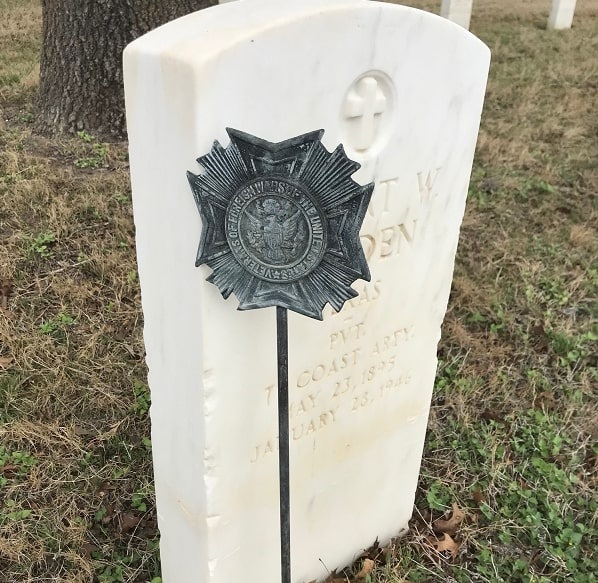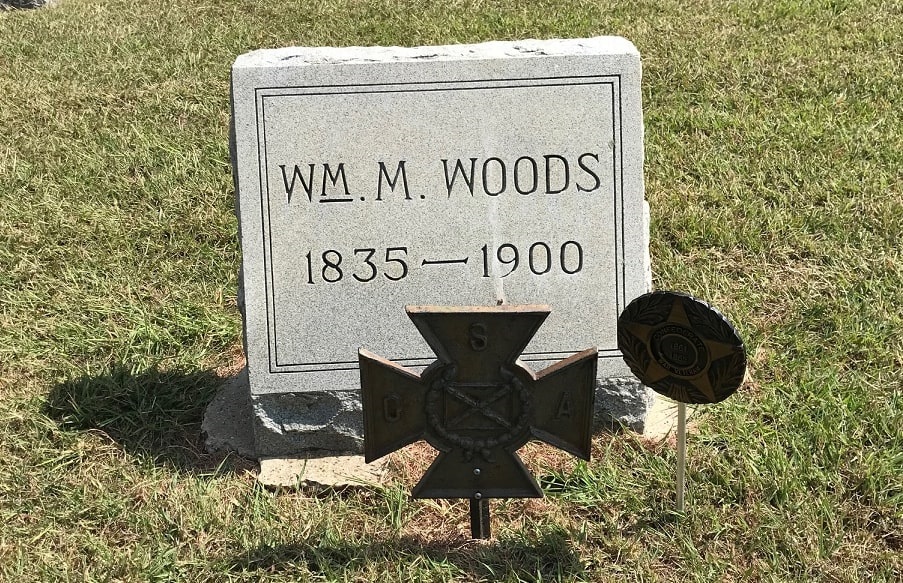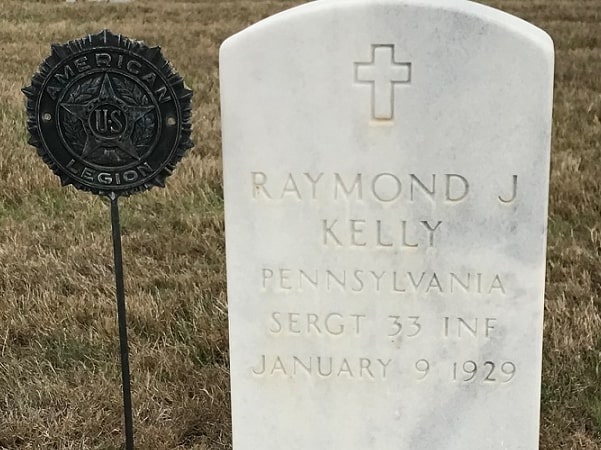Introduction: In this article, Gena Philibert-Ortega gives tips for reading the clues on a veteran’s gravestone, including symbols and accompanying metal markers. Gena is a genealogist and author of the book “From the Family Kitchen.”
Do you have veteran ancestors? Veterans’ burials can be different from those of non-military ancestors. A soldier’s gravestone, whether found in a military or other type of cemetery, provides us details about the soldier – from the type of stone, the text found on the gravestone, and the metal markers placed near the gravestone. In some cases, we need to be able to interpret the meaning behind what’s found on and beside that gravestone.

Veteran Burials
First, it’s important to remember that not all veterans are buried in a military cemetery. Veteran burials may be found in a National Cemetery; however, National Cemeteries only date back to the American Civil War. By the end of the war in 1865, there were 30 National Cemeteries. (1)
Military cemeteries also exist and can be found here and abroad. However, a veteran burial could be just about anywhere, including a city or private cemetery. Outside of a national or military cemetery, a veteran might be buried without a military gravestone – but even then, there may still be clues to military service.
For example, consider this gravestone that includes two metal markers indicating Confederate service in the Civil War. These types of clues shouldn’t be taken as “fact” until you search the appropriate records. These markers can be purchased by anyone and are simply pressed into the ground, which means they could have been moved or placed in error.

Gravestones
If you’ve spent time researching veteran burials marked with a government-issued headstone, you may have noticed they aren’t all the same. The United States government supplied granite gravestones for Civil War (Union) and Spanish American War veterans that included a sunken shield design (or engraved shield depending on when the tombstone was placed). Information about the deceased and their service is found on this shield. Burials for Revolutionary War, War of 1812, Mexican War and Indian Campaigns marked after the Civil War will also have this shield design. (2)
In 1901 Confederate dead were marked in Arlington National Cemetery using a white granite stone that is pointed at the top. It is different from Union grave markers in that it does not have a rounded top. In 1906 the federal government became involved in marking Confederate graves using the same grave marker as first used by Arlington. (3)
Eventually, in 1930 the War Department authorized the addition of the Southern Cross of Honor to be added to the top of Confederate headstones. (4)
After World War I, military headstones feature white granite, upright markers, flat bronze markers, flat granite or flat marble markers, and bronze niche markers for columbarium or mausoleum interment. (5)
Symbols
Military markers may include a symbol at the top middle or middle center of the marker. These symbols correspond with various religious beliefs (although not all – for example, there is a heart emblem and one for atheists). To view what the latest approved emblems are, see National Cemetery Administration Form 40-1330, Claim for Standard Government Headstone or Marker.
Abbreviations
The military, like most occupations, has a language all its own. So, it’s no surprise that you will find abbreviations on military headstones that you may not recognize. These abbreviations will have to do with military conflict, rank, regiment, or honors.
To help with these abbreviations you can find some glossaries online such as the article Military Abbreviations found on US Grave Markers on the ThoughtCo website. Individual PDFs for each military service and their rank abbreviations can be found on the U.S. Department of Veterans Affairs National Cemetery Administration website. A PDF on this website also provides abbreviations for military awards and honors.
Metal Markers
In a previous blog article, Genealogy Tip: What a Gravestone Tells Us – Grave Markers, I discussed metal markers that sometimes can be found next to a gravestone. These metal markers provide more information that can include memberships held, occupations, or military service. In the case of veterans’ headstones, these markers may accompany a military headstone or a non-military-issued headstone for a veteran. You may find what war they served in, or membership in a military group like the Grand Army of the Republic.
Reading a Military Headstone
A military headstone provides more details than name and death date. Note carefully the look of the stone, what symbols are etched into it, and what metal markers accompany it. This information can assist you in learning more about your veteran ancestor.
________________
(1) “From Necessity to Honor: The Evolution of National Cemeteries in the United States,” NPS.Gov (https://www.nps.gov/nr/travel/national_cemeteries/development.html: accessed 23 May 2022).
(2) Clark, Gary W. Cemetery and Gravestone Handbook for Genealogists & Family Historians (PhotoTree.com, 2019), p. 44.
(3) “From Necessity to Honor: The Evolution of National Cemeteries in the United States,” NPS.Gov (https://www.nps.gov/nr/travel/national_cemeteries/development.html: accessed 17 May 2022).
(4) “Confederate Burials in the National Cemetery,” National Cemetery Association (https://www.cem.va.gov/pdf/InterpretiveSigns/ConfederateBurialsInTheNationalCemetery.pdf: accessed 17 May 2022).
(5) Clark, Gary W. Cemetery and Gravestone Handbook for Genealogists & Family Historians (PhotoTree.com, 2019), p. 47.
Explore over 330 years of newspapers and historical records in GenealogyBank. Discover your family story! Start a 7-Day Free Trial
Note on the header image: photo of a military headstone with an “American Legion” metal marker at the Kerrville National Cemetery in Kerrville, Texas. Credit: Gena Philibert-Ortega.
Related Articles:
